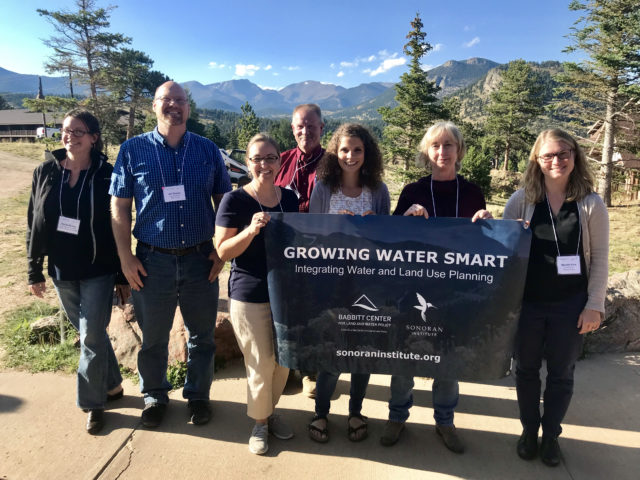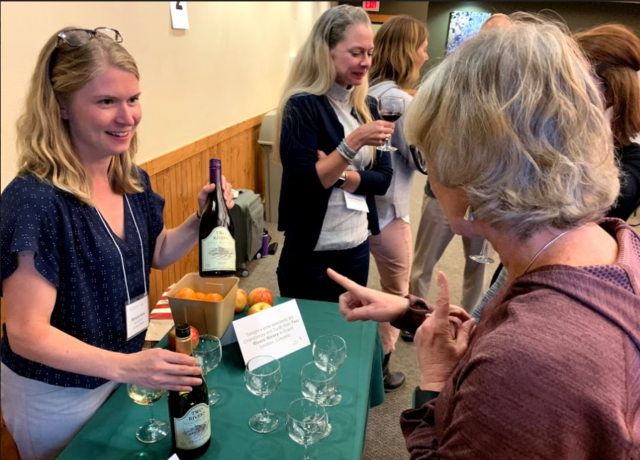
This September, five community teams comprised of Colorado’s Front Range leaders kicked-off our 4th Growing Water Smart workshop, a collaborative environment to develop water and climate resiliency strategies that encourage local economic, social, and environmental goals.
Waverly Klaw and the resilient communities and watershed team put together an experience that works to address each community’s unique conservation challenges. Each Growing Water Smart workshop encourages dialogue across departmental and geographic lines to find solutions to pressing water demand and climate adaption needs.
With all the hard work put in, there was still a little time left over for play. Waverly enjoyed seeing the wildlife around town (elk everywhere!) and taking in the gorgeous scenery at the YMCA of the Rockies. We sat down together to learn more about her time in Estes Park, Colorado, the progress made during the workshop, and the participating communities that are taking steps toward building a resilient and thriving future.
Thoughtful water planning is crucial to future success and growth, and our role is that of a facilitator, offering a helping hand during this process.
–Waverly Klaw, associate director, resilient communities and watersheds

What’s the big goal of hosting these workshops?
Ultimately the “big goal” is thoughtful planning and management of our water supply. Many don’t realize that Colorado faces a significant future gap between water supply and demand. Consider this: a changing climate and growing population could result in a water shortfall for over 1 million Coloradans by 2050. Thoughtful water planning is crucial to future success and growth, and our role is that of a facilitator offering a helping hand during this process.
Thoughtful planning calls community leaders to ask four important questions as they plan for water and climate resiliency:
- How much water do we have?
- What will future water demand look like?
- What will the reality of our future water supply be?
- How can we best translate our water reality into implementable strategies that result in sustainable growth?
Answering these questions allows communities to understand the essential role water plays in achieving long-term economic growth, agricultural productivity, recreational amenity, and ecological health goals.

While new development can be beneficial, a clear problem arises when neither party is really looking down the line to ask, where is this water coming from, and how much do we have?
You mentioned the importance of water in developmental growth, what do the interactions between land-use planners and water providers need to look like as they become more involved in this dialogue?
First, let’s loosely define the roles of land-use planners and water providers.
Land-use planners focus on things like economic growth, community aesthetics, and providing diverse housing opportunities. They are responsible for translating a community’s desire and vision into long-range plans, which in turn impact the codes, rules, and regulations that direct development.
Water providers are focused on selling water and hold a more responsive role as they continue to procure water as needed.
So, the responsibility of bringing water demand and supply into equilibrium lies across both entities. On one side, you have developers or land-use planners reviewing ambitious building projects and seeing the growth projections of their communities, and on the other side, you have water providers responding to the increased water needs of these new development ventures. While new development can be beneficial, a clear problem arises when neither party is really looking down the line to ask, ‘where is this water coming from, and how much do we have?’
With a finite amount of water to work with, we can’t afford not to ask these questions.
With a finite amount of water to work with, we can’t afford not to ask these questions, which is why communication, and lots of it, is very important to ensure water conscious development.
These disconnects are really at the core of why Sonoran Institute and the Babbitt Center for Land and Water Policy began the Growing Water Smart workshops. We wanted to provide an opportunity to bridge communications at all levels of community water and land-use planning.

This workshop was primarily attended by Colorado Front Range leaders, so what were some of the commonalities in the types of challenges these communities are facing?
Many attendees don’t realize that they share similar water challenges with other counties and municipalities, and as with previous workshops, this one was really no exception.
Across the board, we saw municipalities and counties come to a common realization that they don’t have enough data to understand the relationship between patterns of growth and true water supply and demand. This is why participants are encouraged to view future development as part and parcel with water management.
We have seen real results from this approach—combining growth and water management concerns has allowed for long-range comprehensive strategies that better understand and account for supply and demand trends. That becomes part of land use codes, which is where we start to see real change take place in future development. After all, the best time to consider water efficiency is before the building is even built.
What are some specific steps water providers and land-use planners can take to ensure that sustainable measures are taken into account moving forward?
Both water providers and land-use planners have options when it comes to ensuring water conservation and other sustainability measures. Water providers, for example, can take steps to change their rate or tap fee structure to incentivize water conservation. Land-use planners can encourage increased density, require water-efficient landscaping, and require water-efficient indoor appliances and fixtures. Those strategies reinforce each other to grow water smart.
Some of the outcomes we have discussed are policy level-changes to codes, and updates to municipal practices, which can be abstract for people in other lines of work, but who are impacted by these policies. Can you explain why change at a policy level is so important?
Sure, I think the idea is to be as thoughtful as possible in integrating water efficiency, and the best way to do this it is through regulations that govern how a new building or subdivision is built. The details of policy regulations are challenging for pretty much anyone, but frankly, our rationale for focusing on policy-level change is quite simple: changing (retrofitting) existing structures once they are already built is more difficult than accounting for water efficiency other sustainability measures form the get-go. That way the house or development that was built to last 50-100 years is designed for conservation and efficiency.
How do you successfully communicate this to members of the community?
I think it’s crucial to recognize how interconnected it all is when communicating the importance of integrating water conservation and climate adaption into our local policies.
Affordable housing, for example, is a common goal for many Colorado communities. With water becoming scarcer, the cost of locating new water supplies for new community development is increasing, and ultimately that price hike will get passed on to residents and consumers. If a community cares about having affordable housing and development, which I think most do, it must know how much water is available, assess the efficiency of their water management, and identify areas where they can improve. Examples like this hit home, literally.

What big differences do you see among community leaders and staff that have participated? Do they feel more confident about their water future and the wellbeing of their communities?
Community leaders and government staff have expressed that they now know more about what they “don’t know” and need to further research, but that they also feel better equipped to tackle these challenges and develop comprehensive, often “win-win” solutions. This workshop really has such a strong peer-to-peer exchange component, and this collaboration connects community leaders with the right experts and colleagues so that they have the know-how to start implementing these changes and can feel confident about the fact that they are building a resilient future for everyone they serve.
How does Colorado’s water conservation and climate resiliency impact the rest of the Colorado River Basin and the West at large?
The best way to sum up the importance of Colorado’s water supply is through the adage ‘everything goes downstream.’ A whole lot of people live downstream from Colorado, so it’s incumbent on us to take these issues seriously. As for the West, our changing climate will continue to result in hotter summers, changing precipitation patterns, increased wildfires, more extreme droughts, and scarcer water supplies. So, I do think that this unique geographic position at the headwaters of the Colorado River comes with the responsibility and the opportunity to become leaders in water efficiency and share lessons learned not just in our Western communities, but also with other parts of the country.

For readers who have never visited Estes Park, can you share any great local spots that you enjoyed during your time there?
There are so many great breweries in Estes Park. I recommend a visit to Estes Park Brewery, which has a great selection of creative and tasty microbrews. They also generously donated a few cases of their brews to our workshop attendees. Estes Park is such a beautiful place to visit and was an ideal setting to host our Growing Water Smart workshop.
Funding for Growing Water Smart is provided by the Colorado Water Conservation Board, the Lincoln Institute of Land Policy, and the Gates Family Foundation.
Blog Post By: Grace Wofford, Marketing Communications Intern
